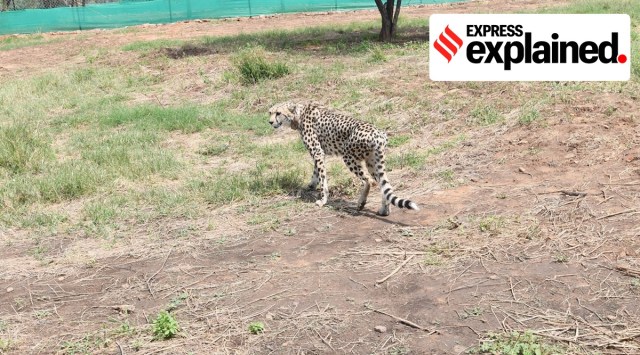Why are cheetahs facing the threat of extinction?
In India, the native cheetah species was the Asiatic cheetah, which went extinct in 1952.
 The initial idea was to bring Asiatic cheetahs here, as a movement within the continent would be easier and help the animals adjust to Indian conditions better, but this was rejected by Iran. (Twitter @narendramodi)
The initial idea was to bring Asiatic cheetahs here, as a movement within the continent would be easier and help the animals adjust to Indian conditions better, but this was rejected by Iran. (Twitter @narendramodi)With eight cheetahs being relocated from Namibia in Africa to India’s Kuno Wildlife Sanctuary in Madhya Pradesh, there is hope that the translocation project for reviving India’s long-extinct cheetah population may achieve success.
In India, the native cheetah species was the Asiatic cheetah, which went extinct in 1952. Currently, only Iran has Asiatic cheetahs in the wild, numbering around 12, and the majority of the remaining 7,000-strong population of the big cats around the world is of African cheetahs – the ones that have now come to India.
Even before this translocation, attempts were made to bring back the animals to India. The initial idea was to bring Asiatic cheetahs here, as a movement within the continent would be easier and help the animals adjust to Indian conditions better, but this was rejected by Iran. One reason was the dwindling population of its own cheetahs. But why does the animal face severe threats of extinction globally?
Why do only African and Asiatic cheetahs remain in the wild?
According to the journal National Geographic, a popular theory on cheetahs’ evolution says they descended from the same ancestor as the American puma, another big cat. This implies cheetahs were not limited to two continents at that point. “About 10,000 to 12,000 years ago, around the end of the last ice age, an extinction event took place that wiped out many large mammal species around the world, including the wild cheetahs of North America and Europe. The extinction of these early cheetah species left only the Asian and African populations of cheetahs”, it says.
A long wait is over, the Cheetahs have a home in India at the Kuno National Park. pic.twitter.com/8FqZAOi62F
— Narendra Modi (@narendramodi) September 17, 2022
Even in the year 1900, it is believed around 100,000 cheetahs may have been alive. Over time with only two species remaining, inbreeding increased in the species. Breeding within a limited set of animals leads to a reduced variety of genes in the overall species population, increasing vulnerability to disease and unfavourable weather conditions.
According to the International Union for Conservation of Nature (IUCN), which is composed of both government and civil society organisations, today cheetahs are mainly present in southern African countries such as Algeria, Botswana, Central African Republic, Ethiopia, Kenya, South Africa and Zimbabwe, among others. Iran is the only country having the Asiatic cheetah.
But why do so few Asiatic cheetahs remain?
Earlier, the populations of the Asiatic cheetahs stretched from the Arabian peninsula to the Indian subcontinent. A little smaller than its African cousin, the Asiatic cheetah has faced numerous threats to its survival. The biggest threat is human intervention, as happened in India.
Over-hunting at the hand of kings, the British, as well as herders who wanted to prevent attacks on their sheep and other animals, was a major factor. The loss of the wide expanse needed for cheetahs’ health and survival, as more and more land got converted into agricultural land, was another reason. Smaller animals, its sources of prey, also reduced in numbers as forest areas were converted.
Other Asian countries have also seen the loss of cheetahs in the 20th century, same as India. In modern-day Iran, the animals often get hit by vehicles close to their areas, as they are prone to moving beyond the zones they are placed in, according to a 2017 report in The Guardian. The same report mentioned cuts in the UN programme to help conservation in the region as another factor that could lead to extinction sooner than expected, back when the population was around 50 cheetahs, which is down to 12 now.
Why is the cheetah vulnerable today?
The Cheetah is assessed as Vulnerable by the IUCN. Under its Red List, which studies and notifies the decline in a species’ population, it comes under the ‘vulnerable’ category meaning it is not very far off from the threat of being extinct in wild. It also said, “If cheetahs outside protected areas are subject to high levels of threat, then the global Cheetah population may decline by more than 50% over the next 15 years”.
Apart from the threats traditionally faced, climate change is further changing the habitats of cheetahs. Poaching is done for the animal’s fur, while illegal smuggling happens due to demand for the big cats as pets in some regions, given they are generally less likely to attack humans.
While a thriving population exists now in South Africa due to conservation efforts in the last few years, the same is not true for the rest of the continent. The growing urbanisation and population increase are to be noted, given cheetahs need a free expanse of land to roam around in. “Preventing a steep decline in the Cheetah population in the face of an ongoing period of rapid growth in Africa’s human population over the next few decades will be the most serious challenge for the conservation of this species”, says the IUCN.
- 01
- 02
- 03
- 04
- 05





































